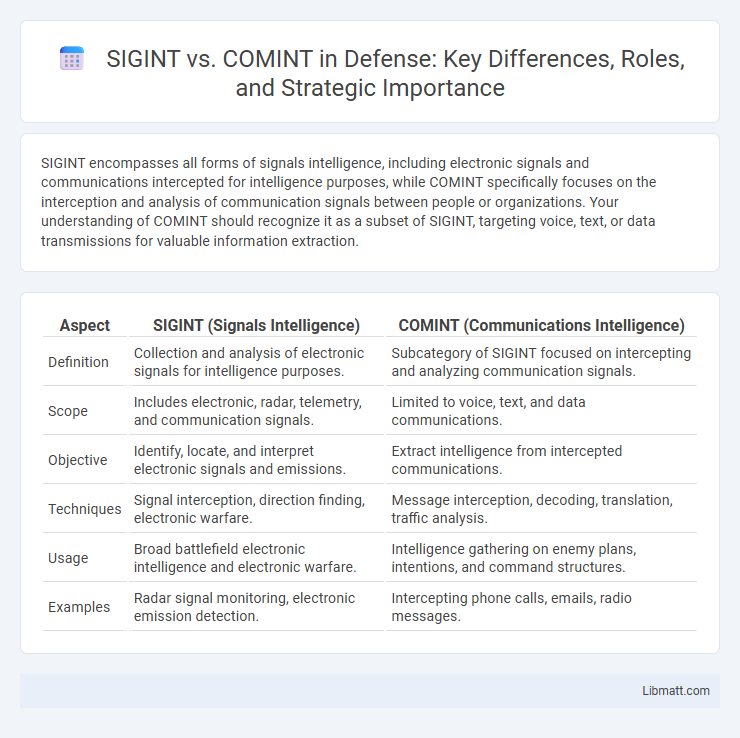SIGINT encompasses all forms of signals intelligence, including electronic signals and communications intercepted for intelligence purposes, while COMINT specifically focuses on the interception and analysis of communication signals between people or organizations. Your understanding of COMINT should recognize it as a subset of SIGINT, targeting voice, text, or data transmissions for valuable information extraction.
Table of Comparison
| Aspect | SIGINT (Signals Intelligence) | COMINT (Communications Intelligence) |
|---|---|---|
| Definition | Collection and analysis of electronic signals for intelligence purposes. | Subcategory of SIGINT focused on intercepting and analyzing communication signals. |
| Scope | Includes electronic, radar, telemetry, and communication signals. | Limited to voice, text, and data communications. |
| Objective | Identify, locate, and interpret electronic signals and emissions. | Extract intelligence from intercepted communications. |
| Techniques | Signal interception, direction finding, electronic warfare. | Message interception, decoding, translation, traffic analysis. |
| Usage | Broad battlefield electronic intelligence and electronic warfare. | Intelligence gathering on enemy plans, intentions, and command structures. |
| Examples | Radar signal monitoring, electronic emission detection. | Intercepting phone calls, emails, radio messages. |
Introduction to SIGINT and COMINT
SIGINT (Signals Intelligence) encompasses the interception and analysis of all types of signals for intelligence purposes, including communications, electronic emissions, and radar signals. COMINT (Communications Intelligence) is a subset of SIGINT focused specifically on intercepting and interpreting voice, text, or data communications between people or organizations. Understanding the distinction helps enhance your ability to leverage electronic surveillance in intelligence gathering.
Defining SIGINT: Scope and Purpose
SIGINT, or Signals Intelligence, encompasses the interception and analysis of all types of electronic signals for intelligence purposes, including communications, radar, and electronic emissions. Its scope spans from military communications to electronic warfare signals, providing critical insights into adversary capabilities and intentions. The purpose of SIGINT is to gather actionable intelligence by monitoring and decoding electronic transmissions, supporting national security and defense operations.
Understanding COMINT: Focus and Function
COMINT, or Communications Intelligence, is a subset of SIGINT (Signals Intelligence) that specifically targets the interception and analysis of communication signals such as voice, text, and data transmissions between individuals or groups. Its function centers on extracting meaningful information from these communications to support intelligence gathering, threat assessment, and decision-making. Your ability to differentiate COMINT from broader SIGINT categories enhances strategic insights in intelligence operations.
Key Differences Between SIGINT and COMINT
SIGINT (Signals Intelligence) encompasses the broader field of intercepting and analyzing electronic signals, including communications, radar, and electronic emissions, while COMINT (Communications Intelligence) specifically targets the interception of voice, text, or data communications between parties. Your understanding of SIGINT involves multiple signal types such as ELINT (Electronic Intelligence) and FISINT (Foreign Instrumentation Signals Intelligence), whereas COMINT focuses exclusively on capturing and deciphering communication content and metadata. Key differences lie in scope and application, with SIGINT providing a comprehensive electronic picture and COMINT offering detailed insights into opponents' communications for tactical and strategic advantage.
Overlap and Interrelation of SIGINT and COMINT
SIGINT (Signals Intelligence) encompasses a broad range of intercepted signals including COMINT (Communications Intelligence), which specifically targets communication transmissions such as phone calls, emails, and radio messages. The overlap between SIGINT and COMINT lies in the collection and analysis of intercepted communication signals to provide actionable intelligence. Your intelligence operations often rely on the interrelation of these disciplines to effectively monitor, decode, and exploit communication channels for strategic advantage.
Core Techniques and Tools Used
SIGINT (Signals Intelligence) encompasses the collection and analysis of all electronic signals, including COMINT (Communications Intelligence), which specifically targets voice, text, and data communications. Core techniques for SIGINT involve signal interception, direction finding, and electronic eavesdropping using advanced receivers, antennas, and spectrum analyzers, while COMINT relies heavily on voice recognition, cryptanalysis, and protocol decoding tools. Your success in intelligence gathering hinges on understanding the distinct applications of software-defined radios, signal processors, and decryption algorithms tailored to these fields.
Historical Evolution of Signals and Communications Intelligence
Signals Intelligence (SIGINT) encompasses the broad collection and analysis of electronic signals, including weapons systems and radar, while Communications Intelligence (COMINT) specifically targets intercepted communications such as phone calls and messages. The historical evolution of SIGINT began during World War I with basic radio interception, advancing significantly in World War II through codebreaking efforts like the British Ultra program, which decrypted German Enigma communications, marking a pivotal development in COMINT. Your understanding of modern intelligence benefits from this evolution, highlighting how SIGINT's broader scope has grown to integrate sophisticated electronic warfare techniques and cyber intelligence capabilities.
Real-World Applications and Case Studies
SIGINT encompasses the broad collection of signals intelligence, including COMINT, which specifically targets communications between individuals or groups. Real-world applications of SIGINT include monitoring electronic signals for military intelligence, terrorism prevention, and cybersecurity, while COMINT plays a critical role in intercepting enemy communications during conflicts like the Cold War and modern counterterrorism operations. Your understanding of these distinctions improves strategic decision-making in intelligence, law enforcement, and national security fields.
Challenges and Ethical Considerations
SIGINT and COMINT present distinct challenges, particularly in data volume management and signal decryption complexity, requiring advanced technologies and analytical expertise. Ethical considerations include privacy violations and the potential misuse of collected information, demanding strict adherence to legal frameworks and oversight. Your awareness of these issues is crucial in balancing national security interests with individual rights.
Future Trends in SIGINT and COMINT
Future trends in SIGINT (Signals Intelligence) emphasize the integration of artificial intelligence and machine learning to rapidly analyze vast datasets from diverse electronic signals. COMINT (Communications Intelligence) is evolving with advancements in quantum encryption and counter-encryption technologies, driving the development of more sophisticated interception and decryption methods. Increasing reliance on multi-domain sensor networks and cyber capabilities will enhance real-time intelligence gathering and operational responsiveness.
SIGINT vs COMINT Infographic

 libmatt.com
libmatt.com